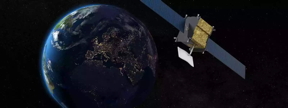Home > Press > University of Strathclyde and National University of Singapore to co-ordinate satellite quantum communications
 |
Abstract:
The University of Strathclyde and the National University of Singapore (NUS) have signed a memorandum of understanding (MoU) on satellite quantum communications, to pave the way for increased joint experiments between the institutions.
University of Strathclyde and National University of Singapore to co-ordinate satellite quantum communications
Glasgow, UK | Posted on May 13th, 2022
Under the agreement, the universities will coordinate so that optical ground stations used by the institutions are able to receive signals from satellites operated by each other.
The MoU is designed to build an international team that shares a consensus on the range of wavelengths used in quantum communications experiments from satellites. Frequency coordination efforts of this kind are regularly carried out in conventional communications.
Enhanced communication between the universities’ respective satellites and ground stations will strengthen partnerships in quantum research between the universities.
Dr Daniel Oi, Senior Lecturer in Strathclyde’s Department of Physics, said: “This is a tremendous opportunity to demonstrate truly global communications secured through quantum means.”
Associate Professor Alexander Ling, a Principal Investigator at the Centre for Quantum Technologies (CQT) at NUS, said: “Through this MoU, we will ensure that our respective satellites and ground stations can talk to each other so that we can do joint work on quantum communication.”
Previously, Dr Oi and Professor Ling collaborated to develop quantum entangled photon sources suitable for satellites, to translate laboratory systems into miniaturised components capable of functioning under the harsh conditions of launch and orbit, and to enable the development of space quantum technologies.
CubeSats, a standard type of nanosatellite made of multiples of 10 cm × 10 cm × 10 cm cubic units, were used for the rapid development and testing of devices and systems at a much faster rate and lower cost than traditional space engineering programmes. The team’s work culminated in the launch of the nanosatellite SpooQy-1 in 2019. This work has inspired similar CubeSat space quantum technology projects worldwide.
A Quantum Technology Cluster is embedded in the Glasgow City Innovation District, an initiative driven by Strathclyde along with Glasgow City Council, Scottish Enterprise, Entrepreneurial Scotland and Glasgow Chamber of Commerce. It is envisaged as a global place for quantum industrialisation, attracting companies to co-locate, accelerate growth, improve productivity and access world-class research technology and talent at Strathclyde.
The University of Strathclyde is the only academic institution that has been a partner in all four EPSRC funded Quantum Technology Hubs in both phases of funding. The Hubs are in: Sensing and Timing; Quantum Enhanced Imaging; Quantum Computing and Simulation, and Quantum Communications Technologies.
Strathclyde leads, and CQT at NUS is a member of, the International Network in Space Quantum Technologies, which tackles the challenges of taking terrestrial quantum technologies into space. It is developing satellite-enabled quantum-secure communication, quantum sensing and timing, with applications in combating climate change, space weather forecasting, satellite navigation, extra-terrestrial surveying, fundamental science and enabling a quantum internet.
####
For more information, please click here
Contacts:
Paul Gallagher
University of Strathclyde
Office: 0044-141-548-2370
Cell: 07969 045919
Copyright © University of Strathclyde
If you have a comment, please Contact us.
Issuers of news releases, not 7th Wave, Inc. or Nanotechnology Now, are solely responsible for the accuracy of the content.
| Related News Press |
News and information
![]()
Engineering piezoelectricity and strain sensitivity in CdS to promote piezocatalytic hydrogen evolution May 13th, 2022
![]()
New nanomechanical oscillators with record-low loss May 13th, 2022
![]()
Small microring array enables large complex-valued matrix multiplication May 13th, 2022
Possible Futures
![]()
Engineering piezoelectricity and strain sensitivity in CdS to promote piezocatalytic hydrogen evolution May 13th, 2022
![]()
New nanomechanical oscillators with record-low loss May 13th, 2022
![]()
Small microring array enables large complex-valued matrix multiplication May 13th, 2022
Announcements
![]()
Engineering piezoelectricity and strain sensitivity in CdS to promote piezocatalytic hydrogen evolution May 13th, 2022
![]()
New nanomechanical oscillators with record-low loss May 13th, 2022
![]()
Small microring array enables large complex-valued matrix multiplication May 13th, 2022
Environment
![]()
Lightening up the nanoscale long-wavelength optoelectronics May 13th, 2022
![]()
New approach can predict pollution from cooking emissions April 15th, 2022
Aerospace/Space
![]()
Lightening up the nanoscale long-wavelength optoelectronics May 13th, 2022
![]()
Studying atomic structure of aluminum alloys for manufacturing modern aircraft March 25th, 2022
![]()
Polymer fibers with graphene nanotubes make it possible to heat hard-to-reach, complex-shaped items February 11th, 2022
Alliances/Trade associations/Partnerships/Distributorships
![]()
CEA and Startup C12 Join Forces to Develop Next-Generation Quantum Computers with Multi-Qubit Chips at Wafer Scale March 25th, 2022
![]()
Wise-integration and EDOM Technology Announce Channel Partnership for GaN IC Power Semiconductor Deployment February 11th, 2022
![]()
QuTech takes important step in quantum computing with error correction: “Until now researchers have encoded and stabilized. We now show that we can compute as well.” December 17th, 2021
Research partnerships
![]()
Nanoclusters self-organize into centimeter-scale hierarchical assemblies April 22nd, 2022
![]()
A solution to perovskite solar cell scalability problems April 22nd, 2022












